-
Car Reviews
- All reviews
- Midsize SUVs
- Small cars
- Utes
- Small SUVs
- Large SUVs
- Large cars
- Sports SUVs
- Sports cars
- Vans
Latest reviews
- Car News
-
Car Comparisons
Latest comparisons
- Chasing Deals
This 4WD might be more than a decade old but Toyota’s tweaks have kept the Prado’s on- and off-road driving dynamics competitive – but the ageing cabin hurts it
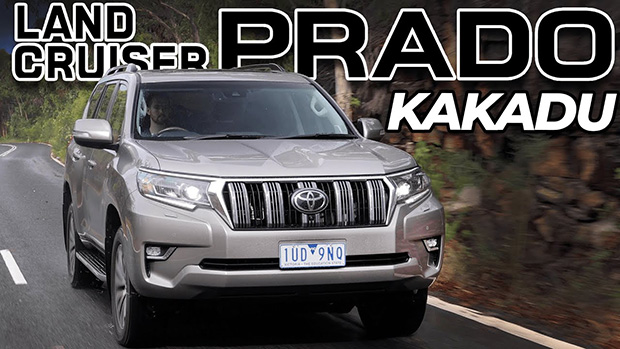
The Toyota Prado turns 13 in 2022. If it were a child, it’d be entering high school – no spring chicken, in other words. But age isn’t always a critical problem, especially in a segment where reliability and durability are key strengths. Could the Prado be a safer, more obvious choice than newcomers like the Ineos Grenadier (from $84,500), or even Toyota’s larger Land Cruiser 300 Series ($101,790)?
The 24/7 media cycle in the motoring industry means we’re often conditioned to see ageing platforms as wholly negative things – but in some segments buyers simply do not feel the same way. That said, there’s only so long a vehicle can be on the market before rivals overtake it entirely, and the 150-series Prado is due for replacement in the middle of this decade.
Clearly, the market doesn’t find the Prado overly long-in-the-tooth just yet. Last year, this smaller Land Cruiser model was Australia’s best-selling large SUV by a significant margin. Its 21,299 sales meant the Prado was more than twice as popular as the Isuzu MU-X (10,618 sales) or the wagon-like Subaru Outback (10,490 units).
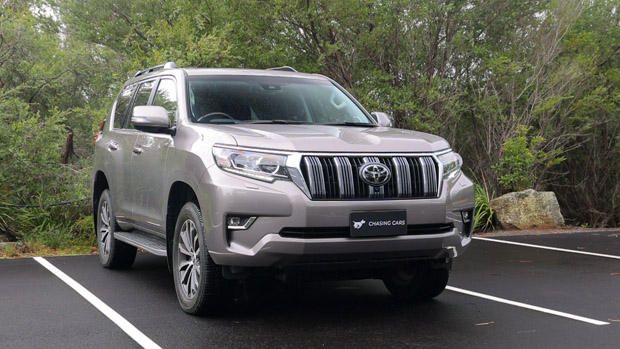
Capable chassis aside, helping to bolster the Prado’s appeal in its twilight era have been regular updates from Toyota: in 2017, the Prado gained a new grille with more chrome and then in August 2020 scored the updated 150kW ‘1GD’ turbo-diesel four-cylinder and Apple CarPlay/Android Auto functionality. Last year, there were further small aesthetic changes at the top of the range and additional safety gear was given to the base GX.
This week, we tested the range-topping MY22 Prado Kakadu ($87,807 before on-road costs), finished in Dusty Bronze over black leather upholstery. The Kakadu can now be distinguished by a new set of ‘Prestige’ 19-inch alloy wheels – Toyota’s parlance – with machine-polished faces and black barrels that add more than a dash of ‘concrete cowboy’ to the Prado’s exterior.
The Prado is available in four variants that span from the rough-and-ready $60,830 five-seat GX entry-grade to the Kakadu tested here. But do you really need the most expensive Prado when the third-tier VX grade is $10,000 cheaper despite also packing ventilated seats and a 360-degree camera?
SUVs may be a suburban vehicle of choice for many Australians, but the body-on-frame Toyota Land Cruiser Prado also finds favour with more adventurous owners. Some hardcore off-roaders may prefer more nimble utes, but the Prado – being usefully narrower than the 300 Series – strikes a great balance between capability and comfort.
Now slightly blinged-up on its polished 19-inch wheels, we wondered if the Kakadu’s off-road chops might have been lost. To find out, we took the top Prado down a steep fire trail and the hill-descent control worked in conjunction with low-range to keep the 4WD’s speed under control easily. Coming back up the slope we encountered a rocky section with offset wombat holes to test rear axle articulation.
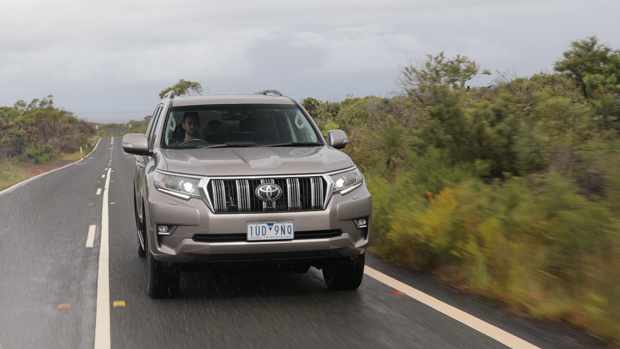
The Kakadu-exclusive and Australian-developed KDSS suspension system is really what sets this range-topping model above all other Prados. It essentially disconnects and reconnects the sway bars using hydraulic pressure rather than electronics. In practice, this means body roll is kept at bay on the tarmac but without restricting off-road capability.
Rolling into the rough bush track, the KDSS disconnected the anti-roll bars providing plenty of wheel articulation and the rear beam axle helped keep the all-terrain tyres in touch with the ground – but the Prado wouldn’t winch itself up the rocky test initially, at least with the differential open. A quick flick of the standard rear differential lock saw traction return and the Prado scooted on up.
In range-topping Kakadu trim you also get ‘Multi Terrain Select’ with sand, mud and rock crawl modes to choose from that adjust the adaptive dampers, throttle response and transmission calibration.
The extra computer complexity wasn’t necessary during our test, and it’s for this reason that arguably the VX and GXL make more sense for pure off-roaders – both grades cost less cash but keep the locking differentials and have identical 30.4º, 23.5º approach and departure angles with 219mm of ground clearance.
What those grades don’t have, though, are the Kakadu’s adaptive dampers which offer Comfort, Normal, Sport and Sport S+ modes which broaden the Prado’s bandwidth on road. In comfort mode, Toyota has done its best to insulate the ride from stutter bumps, but the body-on-frame Prado still elicits some of the lateral judder traditionally associated with this type of chassis. If you are moving from a car-based SUV, you will notice the ride is less refined.
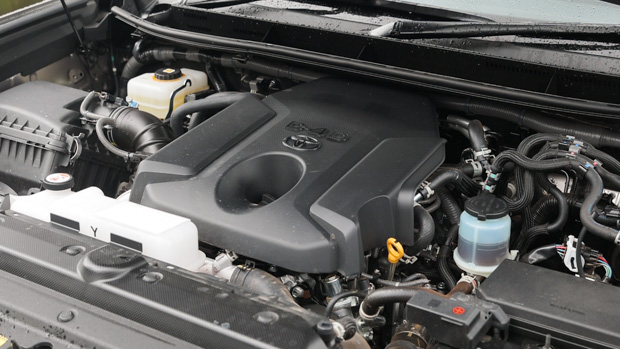
Urban ride quality isn’t astoundingly good; evidently there’s a lot of suspension control needed to keep the Prado’s 2350kg mass in check (the Kakadu’s 19-inch alloys amplify this somewhat) so it’s more comfortable hitting speed humps at 50km/h than 25km/h.
Where the Prado Kakadu really impresses is through a set of corners on a country road when it’s road-friendly suspension tuning and relaxed throttle response – unlike the toey 5.6-litre V8-powered Nissan Patrol – mean you don’t have to think hard about managing the mass.
Where the Prado shows its age – particularly in comparison with the dynamically-superior 300 Series – is in the heavy, leaden steering feel and the wooden brake pedal. But at the end of the day this Prado isn’t a driver’s car, but it is safe and secure for a tall (1880mm) vehicle.
The well-known 150kW/500Nm 2.8-litre turbo-diesel four-cylinder sourced from the Hilux ute offers fairly respectable acceleration time of 10-seconds though under heavy load a tappetty turbo-diesel din makes it into the cabin.
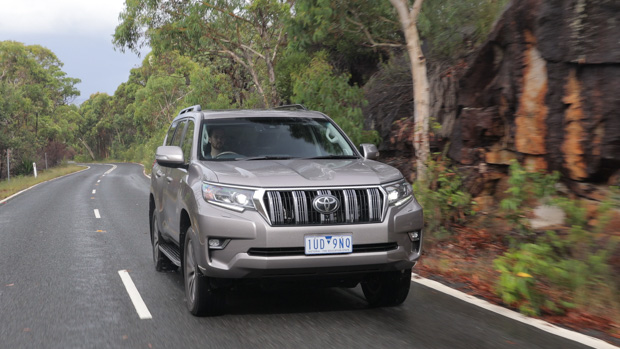
Toyota says it improved the calibration of the Prado’s six-speed automatic transmission, and while it’s much less busy than before holding the 2.8 in its beefy mid-range (the 500Nm figure is spread from 1600-2800rpm), at wide-open throttle the six-speed ‘box still holds gears to the 4500rpm red line.
That said, the auto’s previous, odd behaviour of revving-out even under light or moderate throttle has been eliminated, with the 2.8-litre now being kept closer to its lower-RPM peak torque band, making the driving experience quieter (and more frugal).
But one unfortunate quirk remains: the steering wheel paddle shifters don’t allow proper control over the transmission – they simply limit the highest gear the gearbox will select. The function is there to prevent the four-piston front brake calipers from overheating on long descents, particularly when towing a maximum 3000kg braked towing load.
The Prado scored five stars when tested by ANCAP in 2011 and has better safety hardware than you might expect. At the end of 2022 this rating will expire with ANCAP’s new five-year timeout protocol, but Chasing Cars understands that the Prado will continue to be sold regardless of its safety rating status.
Safety smarts include a tentative adaptive cruise control, a weak lane-keep assist system, helpful blind-spot monitoring, front AEB with pedestrian and cyclist detection and rear cross-traffic alert across the range. Both the VX and Kakadu also get 360-degree cameras as well as front and rear parking sensors.
On paper the inclusion of a 9.0-inch touchscreen with wired Apple CarPlay and Android Auto and analogue dials with Toyota’s well-featured 4.2-inch TFT screen between the instruments sounds great – functional and to-the-point without falling behind other unibody large SUVs such as the Kia Sorento.
And the Prado displays all the usual Toyota characteristics of solid build quality combined with decent materials. However, over time the amount of equipment that has been added (especially to this range-topping Kakadu) means the well-intentioned practicalities aren’t as well integrated as they once were.
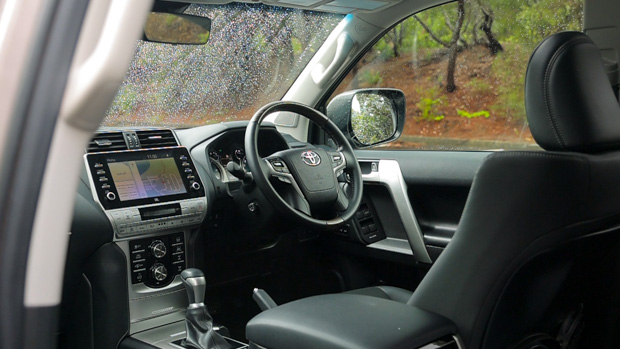
Take the centre console, where there are the rotary controls for the heated and ventilated leather-appointed seats (a nice touch) leave a storage cubby behind that is Tetris block-shaped and not much good for anything but a packet of Werther’s Originals.
Toyota’s continued feature additions also afflict the secondary switchgear such as the controls for the electric mirrors which are awkwardly tucked the steering wheel next to the start/stop button. All of this is frustrating when you first get in the Kakadu, but of course as time passes your interactions become less frustrating.
The central touchscreen helps with handy shortcut buttons on its flanks. The physical HVAC controls (that activate Toyota’s signature icy-cold tri-zone climate control) are simple to interact with, and although it feels clunky to row and automatic shifter through curved gates these days – if it ain’t broke, why fix it?
This ethos cuts to the essence of the Prado Kakadu. As buyers have demanded further niceties and sharper technology more has been thrown in. Really, it needs a full cabin redesign – like its bigger 300 Series sibling – to take full advantage of Toyota’s current tech suite, but at the same time if people are still rushing out to buy it, why worry.
A full redesign is unlikely to occur before the all-new Prado, based on the same TNGA-F frame platform as the new 300 Series, is released in Australia in 2024 or 2025.
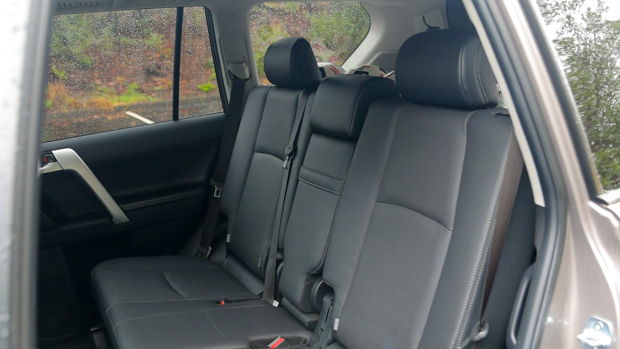
Our test car featured practical (if drab) black leather-accented upholstery, faux-wood trim on the dash and large paddle-equipped steering wheel. For no extra cost, the Kakadu (and VX) are both available with beige leather upholstery which gives the cabin a visual lushness lift.
Speaking of being practical, the Prado unfortunately lacks in this area with small cup holders and not enough space in the door pockets for 1.5-litre water bottles. There is a USB-A charging port in the front next to a 12-volt socket and under the central armrest a generous cooled bin designed specifically with space for four cans.
The second row’s hot-for-2009 inclusion of a Blu-ray player and HDMI port may leave Land Rover Discovery owners scoffing with their 48-volt architecture and Amazon Alexa integration, but with the cheap prices of Sony’s mid-00s premiere video tech you can actually pick up some amazing films for back-seat riders at a stellar price, and you don’t need an internet connection to enjoy them.
Other second-row features include heating for the outboard seats, dual climate zones, a flip-down armrest with two cup holders and plenty of head and knee room for passengers up to (and potentially above) 188cm.
Shifting into the third row doesn’t require any grunting or physical exertion as the Kakadu scores electrically-folding second and third row seating. Once all the way back there, the space is agreeable if you’re under 180cm and there’s even electric backrest adjustment!
If you’re looking for an SUV to regularly carry six or seven around the suburbs though, we still reckon the Hyundai Palisade’s roomy rear end makes it the best choice.
Around the rear you’ll notice our test Prado is fitted with the no-cost option flat tailgate which should make it easier to fit into tight parking spots (being 170mm shorter) but the swing-open door requires plenty of space to open fully. The rear glass hinges up for tight parking spaces when you need to slide in some extra shopping.
We managed to fit 52 soccer balls in the back below the cargo cover which shows that again, the Hyundai Palisade (59 soccer balls) is better for ultimate load carrying.
Update 16/03/22 Toyota Japan has provided boot capacities for the Land Cruiser Prado.

The Land Cruiser Prado has a 104 litre boot with three rows up, that grows to 553 litres with the third row stowed. With all rear seats folded the Prado has 974 litres of space to the window line, or 1833 litres when loaded to the roof.
Where the Prado always had the full-sized V8-powered 200 Series beaten was in fuel consumption. The official ADR combined figures is 7.9L/100km however our testing saw the Prado return 10.5L/100km in combined testing.
This gap has been reduced considerably due to the more frugal diesel V6 used in the new 300 Series, which has returned about 11L/100km in our testing. Expect to see this engine deployed in the next Prado.
The other feature of the flat tailgate Prado is its smaller 87L tank (the standard vehicle has 150L capacity) as the full-size spare is moved underneath the body.
Servicing will cost an affordable $1560 for the class over a three years/60,000km period owing to the Prado’s shorter-than-your-average SUV six month/10,000km intervals.
This matches the recommended interval for the Land Cruiser 300 Series ($2250 for three years) and Nissan Patrol ($3236 for three years) and reflects the added complication associated with 4WD vehicles.
Toyota backs the Prado – and all of its cars in Australia – with a five year, unlimited kilometre warranty. The brand’s warranty also extends to genuine parts such as spark plugs and suspension components which, when purchased from a dealer, are backed by a two-year guarantee.
Like a dependable labrador, the Prado’s quiet confidence and laid back attitude is what makes this 4WD so endearing. It works well enough on the road that there are no surprises, and with the Kakadu’s KDSS it can really hustle along a good stretch of road.
The fact the Prado can do all that and effortlessly climb technical off-road sections makes it a perfect vehicle for touring Australia. Add in the Prado’s 3000kg braked towing capacity and no wonder its popularity spiked during the pandemic.
Of course, the Prado isn’t perfect. The interior feels slightly incoherent now owing to all the tech and features that have been added over the years, and it isn’t the most attractive cabin to look at. Ultimately we’d probably save some money and go for the GXL or VX and amplify the Prado’s off-road capability with the huge array of aftermarket equipment.
The Prado might not be fast, or grab headlines like the new full-size 300 Series, but this humble package is clearly one that works for a lot of Australians and we can see why.
Variant tested KAKADU FLAT TAILGATE
Key specs (as tested)
About Chasing cars
Chasing Cars reviews are 100% independent.
Because we are powered by Budget Direct Insurance, we don’t receive advertising or sales revenue from car manufacturers.
We’re truly independent – giving you Australia’s best car reviews.
The estimate provided does not take into account your personal circumstances but is intended to give a general indication of the cost of insurance, in order to obtain a complete quote, please visit www.budgetdirect.com.au. Estimate includes 15%^ online discount.
^Conditions Apply
Budget Direct Insurance arranged by Auto & General Services Pty Ltd ACN 003 617 909(AGS) AFSL 241 411, for and on behalf of the insurer, Auto & General Insurance Company Limited(ABN 42 111 586 353, AFSL 285 571).Because we don’t know your financial needs, we can’t advise you if this insurance will suit you. You should consider your needs and the Product Disclosure Statement before making a decision to buy insurance. Terms and conditions apply.
Indicative quote based on assumptions including postcode , 40 year old male with no offences, licence suspensions or claims in the last 5 years, a NCD Rating 1 and no younger drivers listed. White car, driven up to 10,000kms a year, unfinanced, with no modifications, factory options and/or non-standard accessories, private use only and garaged at night.
^Online Discounts Terms & Conditions
1. Discounts apply to the premium paid for a new Budget Direct Gold Comprehensive Car Insurance, Third Party Property Only or Third Party Property, Fire & Theft Insurance policy initiated online on or after 29 March 2017. Discounts do not apply to optional Roadside Assistance.
2. Discounts do not apply to any renewal offer of insurance.
3. Discounts only apply to the insurance portion of the premium. Discounts are applied before government charges, taxes, levies and fees, including instalment processing fees (as applicable). The full extent of discounts may therefore be impacted.
4. We reserve the right to change the offer without notice.